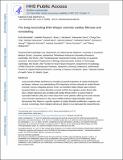| dc.contributor.author | Micheletti, Rudi | |
| dc.contributor.author | Plaisance, Isabelle | |
| dc.contributor.author | Abraham, Brian J. | |
| dc.contributor.author | Sarre, Alexandre | |
| dc.contributor.author | Ting, Ching-Chia | |
| dc.contributor.author | Alexanian, Michael | |
| dc.contributor.author | Maric, Daniel | |
| dc.contributor.author | Maison, Damien | |
| dc.contributor.author | Nemir, Mohamed | |
| dc.contributor.author | Schroen, Blanche | |
| dc.contributor.author | González, Arantxa | |
| dc.contributor.author | Ounzain, Samir | |
| dc.contributor.author | Pedrazzini, Thierry | |
| dc.contributor.author | Young, Richard A. | |
| dc.date.accessioned | 2018-07-20T21:35:18Z | |
| dc.date.available | 2018-07-20T21:35:18Z | |
| dc.date.issued | 2017-06 | |
| dc.identifier.issn | 1946-6234 | |
| dc.identifier.issn | 1946-6242 | |
| dc.identifier.uri | http://hdl.handle.net/1721.1/117041 | |
| dc.description.abstract | Long noncoding RNAs (lncRNAs) are emerging as powerful regulators of cardiac development and disease. However, our understanding of the importance of these molecules in cardiac fibrosis is limited. Using an integrated genomic screen, we identified Wisper (Wisp2 super-enhancer–associated RNA) as a cardiac fibroblast–enriched lncRNA that regulates cardiac fibrosis after injury. Wisper expression was correlated with cardiac fibrosis both in a murine model of myocardial infarction (MI) and in heart tissue from human patients suffering from aortic stenosis. Loss-of-function approaches in vitro using modified antisense oligonucleotides (ASOs) demonstrated that Wisper is a specific regulator of cardiac fibroblast proliferation, migration, and survival. Accordingly, ASO-mediated silencing of Wisper in vivo attenuated MI-induced fibrosis and cardiac dysfunction. Functionally, Wisper regulates cardiac fibroblast gene expression programs critical for cell identity, extracellular matrix deposition, proliferation, and survival. In addition, its association with TIA1-related protein allows it to control the expression of a profibrotic form of lysyl hydroxylase 2, implicated in collagen cross-linking and stabilization of the matrix. Together, our findings identify Wisper as a cardiac fibroblast–enriched super-enhancer–associated lncRNA that represents an attractive therapeutic target to reduce the pathological development of cardiac fibrosis in response to MI and prevent adverse remodeling in the damaged heart. | en_US |
| dc.publisher | American Association for the Advancement of Science (AAAS) | en_US |
| dc.relation.isversionof | http://dx.doi.org/10.1126/SCITRANSLMED.AAI9118 | en_US |
| dc.rights | Article is made available in accordance with the publisher's policy and may be subject to US copyright law. Please refer to the publisher's site for terms of use. | en_US |
| dc.source | PMC | en_US |
| dc.title | The long noncoding RNA Wisper controls cardiac fibrosis and remodeling | en_US |
| dc.type | Article | en_US |
| dc.identifier.citation | Micheletti, Rudi, Isabelle Plaisance, Brian J. Abraham, Alexandre Sarre, Ching-Chia Ting, Michael Alexanian, Daniel Maric, et al. “The long noncoding RNA Wisper controls cardiac fibrosis and remodeling” Science Translational Medicine 9, no. 395 (June 21, 2017): eaai9118. | en_US |
| dc.contributor.department | Massachusetts Institute of Technology. Department of Biology | en_US |
| dc.contributor.mitauthor | Young, Richard A | |
| dc.relation.journal | Science Translational Medicine | en_US |
| dc.eprint.version | Author's final manuscript | en_US |
| dc.type.uri | http://purl.org/eprint/type/JournalArticle | en_US |
| eprint.status | http://purl.org/eprint/status/PeerReviewed | en_US |
| dc.date.updated | 2018-07-13T17:09:01Z | |
| dspace.orderedauthors | Micheletti, Rudi; Plaisance, Isabelle; Abraham, Brian J.; Sarre, Alexandre; Ting, Ching-Chia; Alexanian, Michael; Maric, Daniel; Maison, Damien; Nemir, Mohamed; Young, Richard A.; Schroen, Blanche; González, Arantxa; Ounzain, Samir; Pedrazzini, Thierry | en_US |
| dspace.embargo.terms | N | en_US |
| dc.identifier.orcid | https://orcid.org/0000-0001-8855-8647 | |
| mit.license | PUBLISHER_POLICY | en_US |
